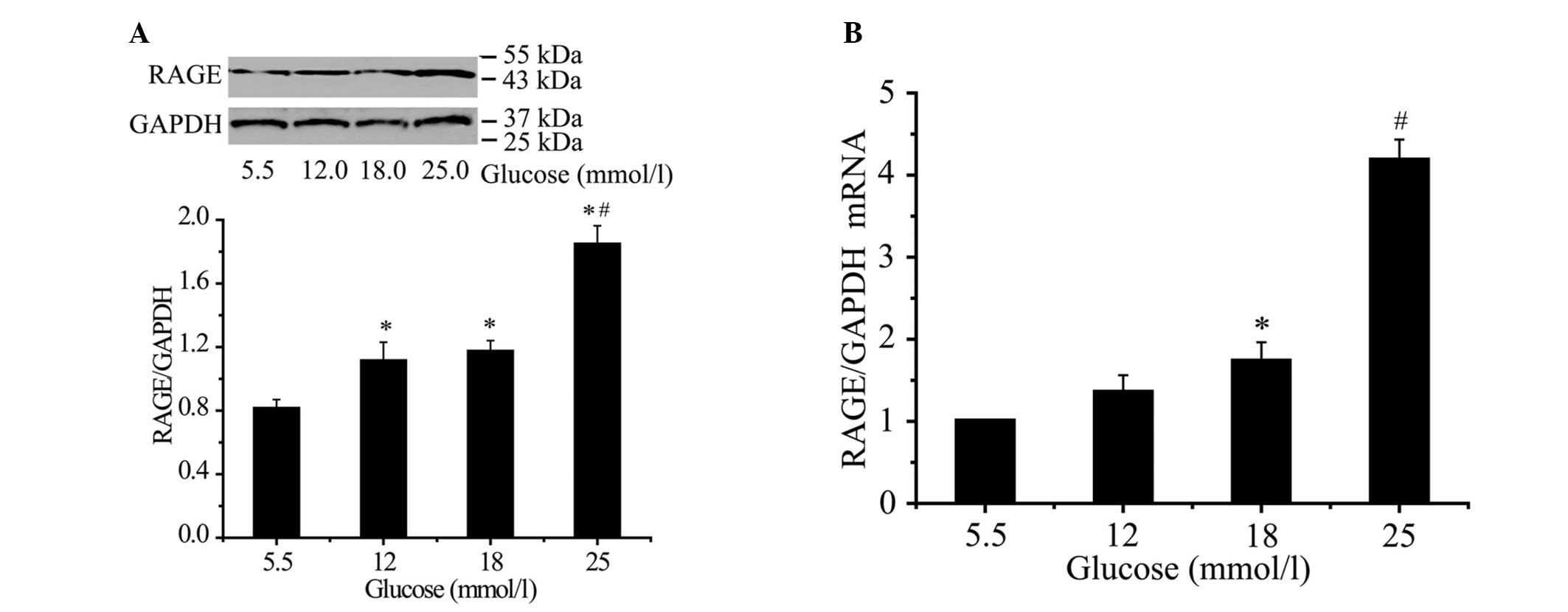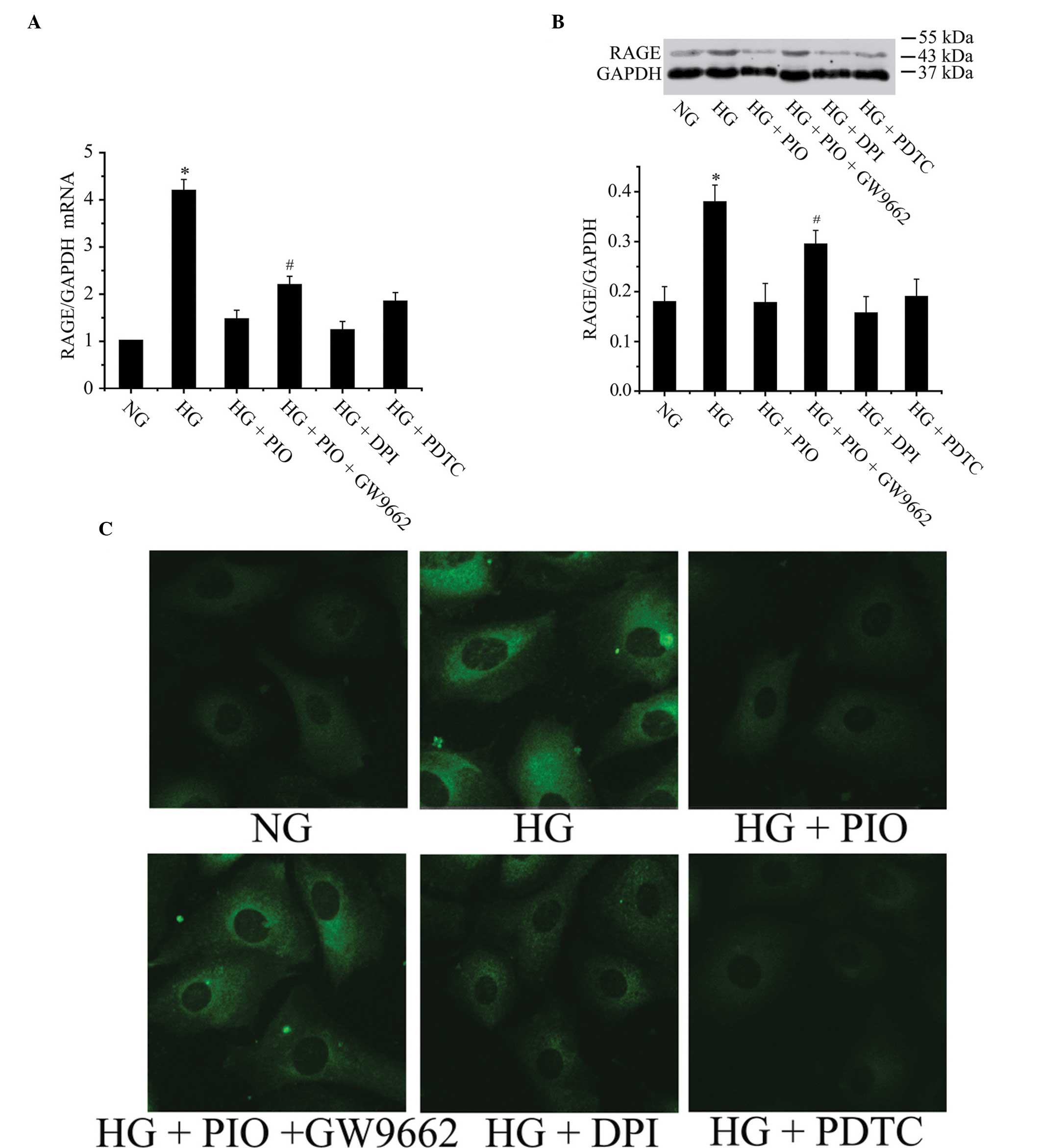|
1
|
Hofmann MA, Drury S, Fu C, et al: RAGE
mediates a novel proinflammatory axis: A central cell surface
receptor for S100/calgranulin polypeptides. Cell. 97:889–901. 1999.
View Article : Google Scholar : PubMed/NCBI
|
|
2
|
Bierhaus A and Nawroth PP: Multiple levels
of regulation determine the role of the receptor for AGE (RAGE) as
common soil in inflammation, immuneresponses and diabetes mellitus
and its complications. Diabetologia. 52:2251–2263. 2009. View Article : Google Scholar : PubMed/NCBI
|
|
3
|
Leclerc E, Fritz G, Vetter SW and Heizmann
CW: Binding of S100 proteins to RAGE: An update. Biochim Biophys
Acta. 1793:993–1007. 2009. View Article : Google Scholar : PubMed/NCBI
|
|
4
|
Gao X, Zhang HR, Schmidt AM and Zhang C:
AGE/RAGE produces endothelial dysfunction in coronary arterioles in
Type 2 diabetic mice. Am J Physiol Heart Circ Physiol.
295:H491–H498. 2008. View Article : Google Scholar : PubMed/NCBI
|
|
5
|
Sakaguchi T, Yan SF, Yan SD, et al:
Central role of rage dependent neointimal expansion in arterial
restenosis. J Clin Invest. 111:959–972. 2003. View Article : Google Scholar : PubMed/NCBI
|
|
6
|
Cipollone F, Iezzi A, Fazia M, et al: The
receptor rage as a progression factor amplifying
arachidonate-dependent inflammatory and proteolytic response in
human atherosclerotic plaques: Role of glycemic control.
Circulation. 108:1070–1077. 2003. View Article : Google Scholar : PubMed/NCBI
|
|
7
|
Wang K, Zhou Z, Zhang M, et al: Peroxisome
proliferator activated receptor gamma down-regulates receptor for
advanced glycation end products and inhibits smooth muscle cell
proliferation in a diabetic and nondiabetic rat carotid artery
injury model. J Pharmacol Exp Ther. 317:37–43. 2006. View Article : Google Scholar
|
|
8
|
De Oliveira C, Colette C, Monnier L,
Descomps B and Pares-Herbute N: Insulin alters nuclear
factor-lambdab and peroxisome proliferator-activated receptor-gamma
protein expression induced by glycated bovine serum albumin in
vascular smooth-muscle cells. J Lab Clin Med. 145:1440–1450. 2005.
View Article : Google Scholar
|
|
9
|
Li H, Chai Q, Gutterman DD and Liu Y:
Elevated glucose impairs cAMP mediated dilation by reducing Kv
channel activity in rat small coronary smooth muscle. Am J Physiol
Heart Circ Physiol. 285:H1213–H1219. 2003.PubMed/NCBI
|
|
10
|
Yoon SJ, Yoon YW, Lee BK, et al: Potential
role of hmg coareductase inhibitor on oxidative stress induced by
advanced glycation endproducts in vascular smooth muscle cells of
diabetic vasculopathy. Exp Mol Med. 41:802–811. 2009. View Article : Google Scholar : PubMed/NCBI
|
|
11
|
Yoon YW, Kang TS, Lee BK, et al:
Pathobiological role of advanced glycation endproducts via
mitogen-activated protein kinase dependent pathway in the diabetic
vasculopathy. Exp Mol Med. 40:398–406. 2008. View Article : Google Scholar : PubMed/NCBI
|
|
12
|
San Martin A, Foncea R, Laurindo FR, et
al: Nox1-based nadph oxidase-derived superoxide is required for
vsmc activation by advanced glycation end-products. Free Radic Biol
Med. 42:1671–1679. 2007. View Article : Google Scholar : PubMed/NCBI
|
|
13
|
Sakata N, Meng J and Takebayashi S:
Effects of advanced glycation end products on the proliferation and
fibronectin production of smooth muscle cells. J Atheroscler
Thromb. 7:169–176. 2000. View Article : Google Scholar
|
|
14
|
Ren X, Shao H, Wei Q, Sun Z and Liu N:
Advanced glycation end products enhance calcification in vascular
smooth muscle cells. J Int Med Res. 37:847–854. 2009. View Article : Google Scholar : PubMed/NCBI
|
|
15
|
Tanikawa T, Okada Y, Tanikawa R and Tanaka
Y: Advanced glycation end products induce calcification of vascular
smooth muscle cells through rage/p38 mapk. J Vasc Res. 46:572–580.
2009. View Article : Google Scholar : PubMed/NCBI
|
|
16
|
Wei Q, Ren X, Jiang Y, Jin H, Liu N and Li
J: Advanced glycation end products accelerate rat vascular
calcification through RAGE/oxidative stress. BMC Cardiovasc Disord.
13:132013. View Article : Google Scholar : PubMed/NCBI
|
|
17
|
Hayakawa E, Yoshimoto T, Sekizawa N,
Sugiyama T and Hirata Y: Overexpression of receptor for advanced
glycation end products induced monocyte chemoattractant protein-1
expression in rat vasculat smooth muscle cell line. J Atheroscler
Thromb. 19:13–22. 2012. View
Article : Google Scholar
|
|
18
|
Soro-Paavonen A, Watson AM, Li J, Paavonen
K, et al: Receptor for advanced glycation end products (RAGE)
deficiency attenuates the development of atherosclerosis in
diabetes. Diabetes. 57:2461–2469. 2008. View Article : Google Scholar : PubMed/NCBI
|
|
19
|
Bu DX, Rai V, Shen X, et al: Activation of
the ROCK1 branch of the transforming growth factor-beta pathway
contributes to RAGE-dependent acceleration of atherosclerosis in
diabetic ApoE-null mice. Circ Res. 106:1040–1051. 2010. View Article : Google Scholar : PubMed/NCBI
|
|
20
|
Ueno H, Koyama H, Shoji T, et al: Receptor
for advanced glycation end-products (RAGE) regulation of adiposity
and adiponectin is associated with atherogenesis in apoE-deficient
mouse. Atherosclerosis. 211:431–436. 2010. View Article : Google Scholar : PubMed/NCBI
|
|
21
|
Li J and Schmidt AM: Characterization and
functional analysis of the promoter of RAGE, the receptor for
advanced glycation end products. J Biol Chem. 272:16498–16506.
1997. View Article : Google Scholar : PubMed/NCBI
|
|
22
|
Yuan X1, Zhang Z, Gong K, Zhao P, Qin J
and Liu N: Inhibition of reactive oxygen species/extracellular
signal-regulated kinases pathway by pioglitazone attenuates
advanced glycation end products-induced proliferation of vascular
smooth muscle cells in rats. Biol Pharm Bull. 34:618–623. 2011.
View Article : Google Scholar : PubMed/NCBI
|














